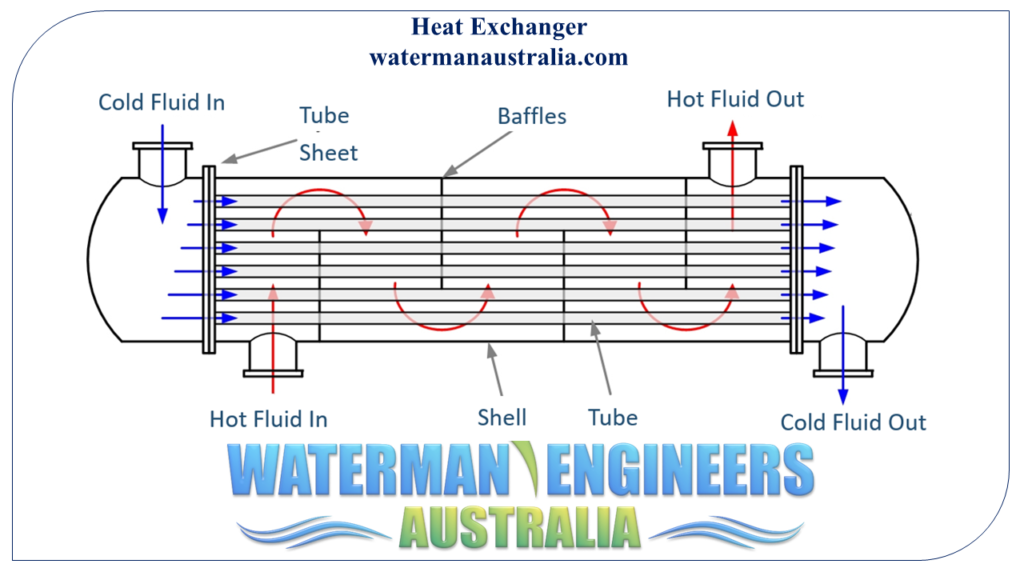
A heat exchanger is a device that allows for the transmission of heat between two different media without any physical contact between them. Heat exchangers work on the idea that thermal energy can be transferred from a hot fluid to a cold fluid. Heat exchangers provide for precise temperature regulation, improving energy efficiency and system functionality by transferring heat between two fluids.
Power plants, chemical plants, HVAC (heating, ventilation, and air conditioning) systems, supermarkets, and many more all employ heat exchangers. They can be found in commonplace home products like air conditioners and water heaters.
In this article, we'll learn about heat exchangers, what they are, how they work, and the different kinds there are. The article also details the common uses and factors to consider when choosing a heat exchanger.
For soiled and viscous fluids, the fouled strain fall inside a heat exchanger could be as many as thrice the clean up stress drop, each inside and outside tubes. Maintaining velocities large enough to stop deposits, steering clear of stagnant location/scorching spot/chilly place are mitigation actions in heat exchanger thermal style and design. Inside the HTRI software package, fouling layer thickness could be entered instantly.
Additionally, Mitsubishi Electrical employed proprietary Assessment technology to develop a new fin layout that appreciably enhances drainage, reducing the condition of melted frost water freezing over the fins and lowering air contact with the heat exchanger, which lowers functionality.
Fluids with vapor stage should be to the shell facet since it offers greater volume to match its decreased heat transfer coefficient.
Choose the product that could very best match your individual desires. Features for example Area available for installation, Trade fee necessary, and the specified performance should be thought of. However, almost every single producer has various ways of reporting efficiency figures.
The lover needs to have ample electricity to overcome the pressure fall and keep the desired air stream price. HTRI Xace can be used as a guideline, but ordinarily the enthusiast producer has their particular system.
This also relies upon on if the tubes along with the shell hold the exact or diverse metallurgies, as being the coefficient of thermal enlargement varies between various supplies.
The overall concepts in the mechanical design and style of the subsequent varieties of exchangers are supplied inside the
The general heat transfer coefficient determined by the outside surface area location from the wall with the unfinned tubular heat exchangers,
The pattern with the EAHX exit air temperature is similar to the surface air temperature but dampened and slightly ahead shifted in time. The extent in the dampening and from the ahead shifting determines EAHX cooling performance.
It's two compact metal wires within a tube that conducts electric power once they’re heated, sending a signal to your fuel valve to enable the fuel to flow. Should the thermocouple will not perception heat from the pilot light or even the element has absent terrible, it will eventually shut off the fuel.
Anthony Rollett (ideal) and his team while in the 3D printing lab Place. Image: School of Engineering, Carnegie Mellon “Instead of picking some alloy and indicating, ‘this appears as if it would do The task,’ and afterwards perhaps getting that we will not print it, I'd instead attempt to set it into some systematic structure and a databases of some sort,” Rollett claimed. “So, if one thing will not exercise, I can Check out another applicant.”
ten. Flanges. Three sorts of flanges are located in shell and tube exchangers, namely, Girth flanges to the shell and channel barrels; internal flanges while in the floating head exchanger to permit disassembly with the internals and elimination on the tube bundle; and nozzle flanges the place the flange and gasket specifications, the scale and strain ranking is going to be set by the line specification. Figure 5 exhibits 3 different types of flanges.
We now have seen the Heat Exchanger is usually a mechanical system which is utilized to transfer thermal Power involving two or more circulating Designing of heat exchanger manufacturer fluids at diverse temperatures.
Each the mechanical design and style and thermal layout shall for that reason be the accountability on the supplier when both guarantees are being supplied, which, as mentioned higher than, includes some premium Charge.